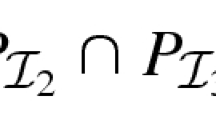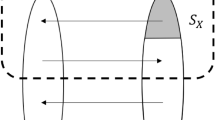Abstract
In this paper we study the inverse problem of matroid intersection: Two matroids M 1 = (E, \({\mathcal{I}}\) 1) and M 2 = (E, \({\mathcal{I}}\) 2), their intersection B, and a weight function w on E are given. We try to modify weight w, optimally and with bounds, such that B becomes a maximum weight intersection under the modified weight. It is shown in this paper that the problem can be formulated as a combinatorial linear program and can be further transformed into a minimum cost circulation problem. Hence it can be solved by strongly polynomial time algorithms. We also give a necessary and sufficient condition for the feasibility of the problem. Finally we extend the discussion to the version of the problem with Multiple Intersections.
Similar content being viewed by others
References
R.K. Ahuja, T.L. Magnanti, and J.B. Orlin, Network Flows: Theory, Algorithms, and Applications, Prentice Hall: NJ, 1993.
D. Burton and Ph.L. Toint, "On an instance of the inverse shortest paths problem," Mathematical Programming, vol. 53, pp. 45-61, 1992.
A. Frank, "An algorithm for submodular functions on graphs," Annals of Discrete Mathematics, vol. 16, pp. 97-120, 1982.
A.V. Goldberg, ´E. Tardos, and R.E. Tarjan, "Network flow algorithms," Technical Report STAN-CS-89-1252, Department of Computer Science, Stanford University, Stanford, CA, March 1989.
M. Gr¨otschel, L. Lovasz, and A. Schrijver, Geometric Algorithm and Combinatorial Optimization, Springer: Berlin, 1993.
Z. Hu and Z. Liu, "A strongly polynomial algorithm for the inverse shortest arborescence problem," Discrete Appl. Math., vol. 82, pp. 135-154, 1998.
S. Huang and Z. Liu, "On the inverse problem of k-matching of bipartite graph," to appear in European J. Operations Research.
E. Lawler, Combinatorial Optimization: Networks and Matroids, Holt Rinehart Winston: New York, 1976.
J.B. Orlin, "A Faster Strongly Polynomial Minimum Cost Flow Algorithm," in Proc. 20th ACM Symp. on the Theory of Comp, 1988, pp. 377-387.
A. Recski, Matroid Theory and its Applications, Springer: Berlin, 1989.
´E. Tardos, "A strongly polynomial minimum cost circulation algorithm," Combinatorica, vol. 5, pp. 247-255, 1985.
´E. Tardos, "A strongly polynomial algorithm to solve combinatorial linear programs," Operations Research, vol. 34, pp. 250-256, 1986.
D. Welsh, Matroid Theory, Academic Press: London, 1976.
J. Zhang and Z. Ma, "A network flow method for solving some inverse combinatorial optimization problems," Optimization, vol. 37, pp. 59-72, 1996.
J. Zhang, Z. Ma, and C.Yang, "Acolumn generation method for inverse shortest path problems," ZORMathematical Methods of Operations Research, vol. 41, pp. 347-358, 1995.
J. Zhang, S. Xu, and Z. Ma, "An algorithms for inverse minimum spanning tree problem," Optimization Methods and Software, vol. 8, pp. 69-84, 1997.
Author information
Authors and Affiliations
Rights and permissions
About this article
Cite this article
Mao-Cheng, C. Inverse Problems of Matroid Intersection. Journal of Combinatorial Optimization 3, 465–474 (1999). https://doi.org/10.1023/A:1009883605691
Issue Date:
DOI: https://doi.org/10.1023/A:1009883605691




